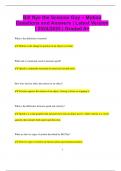-
1. Exam (elaborations) - Bill nye: friction questions and answers | latest version | 100% pass
-
2. Exam (elaborations) - Bill nye the science guy: cells | latest update | 2024/2025 | already passed
-
3. Exam (elaborations) - Bill nye the science guy • evolution | latest update | 2024/2025 | already passed
-
4. Exam (elaborations) - Gravity- bill nye questions and answers | latest update | 2024/2025 | 100% pass
-
5. Exam (elaborations) - Bill nye erosion questions and answers | 2024/2025 | graded a+
-
6. Exam (elaborations) - Bill nye: food webs questions and answers | latest version | 2024/2025 | already pas...
-
7. Exam (elaborations) - Bill nye: sound questions and answers | 2024/2025 | 100% pass
-
8. Exam (elaborations) - Bill nye the science guy – motion questions and answers | latest version | 2024/20...
-
9. Exam (elaborations) - Bill nye storms questions and answers | latest update | graded a+
-
10. Exam (elaborations) - Bill nye: climates questions and answers | latest version | 2024/2025 | 100% pass
-
11. Exam (elaborations) - Bill nye earthquake | latest update | 2024/2025 | graded a+
-
12. Exam (elaborations) - Bill nye sun video questions and answers | latest version | 2024/2025 | already pass...
-
13. Exam (elaborations) - Bill nye, the science guy- energy questions and answers | latest update | 2024/2025 |...
-
14. Exam (elaborations) - Edpuzzle (bill nye: momentum) questions and answers | latest update | 2024/2025 | gra...
-
15. Exam (elaborations) - Bill nye: phases of matter questions and answers | 2024/2025 | 100% pass
-
16. Exam (elaborations) - Bill nye: chemical reactions questions and answers | 2024/2025 | 100% pass
-
17. Exam (elaborations) - Bill nye science questions and answers | 2024/2025 | rated a+
-
18. Exam (elaborations) - Bill nye: biodiversity questions and answers graded a+
-
19. Exam (elaborations) - Biology bill nye genetics video questions and answers | 2024/2025 | graded a+
-
20. Exam (elaborations) - Bill nye plants questions and answers | 2024/2025 | graded a+
-
21. Exam (elaborations) - Bill nye notes questions and answers | latest update | graded a+
-
22. Exam (elaborations) - Bill nye space exploration video questions and answers 100% pass
-
23. Exam (elaborations) - Science bill nye questions and answers | 2024/2025 | rated a+
-
24. Exam (elaborations) - Bill nye magnetism questions and answers | 2024/2025 | graded a+
-
25. Exam (elaborations) - Bill nye outer space questions and answers 100% pass
-
26. Exam (elaborations) - Bill nye - wind questions and answers already passed
-
27. Exam (elaborations) - Bill nye: the moon questions and answers rated a+
-
28. Exam (elaborations) - Bill nye: light and color questions and answers | 2024/2025 | graded a+
-
29. Exam (elaborations) - Bill nye: respiration questions and answers | latest update | 100% pass
-
30. Exam (elaborations) - Bill nye: fossils questions and answers | latest update | graded a+
-
31. Exam (elaborations) - Bill nye moon questions and answers | latest version | already passed
-
32. Exam (elaborations) - Bill nye waves questions and answers | latest update | 2024/2025 | graded a+
-
33. Exam (elaborations) - Bill nye sound questions and answers | latest version | 2024/2025 | graded a+
-
34. Exam (elaborations) - Bill nye the science guy energy questions and answers 100% pass
-
35. Exam (elaborations) - Bill nye heat review questions and answers | 2024/2025 | already passed
-
36. Exam (elaborations) - Bill nye wind worksheet questions and answers | latest update | graded a+
-
37. Exam (elaborations) - Bill nye motion quiz | latest update | 2024/2025 | graded a+
-
38. Exam (elaborations) - Bill nye water cycle questions and answers | latest update | 2024/2025 | graded a+
-
39. Exam (elaborations) - Bill nye the science guy light & color questions and answers | latest version | grad...
-
40. Exam (elaborations) - Bill nye: rocks and soil questions and answers | latest version | 2024/2025 | 100% p...
-
41. Exam (elaborations) - Cells - bill nye video questions and answers | 2024/2025 | already passed
-
42. Exam (elaborations) - Energy, bill nye questions and answers | latest update | 2024/2025 | rated a+
-
43. Exam (elaborations) - Bill nye - the planets questions and answers | latest update | 2024/2025 | graded a+
-
44. Exam (elaborations) - Science gp3 greatest discoveries with bill nye-physics questions and answers | latest...
-
45. Exam (elaborations) - Bill nye: earth's crust questions and answers | latest version | 2024/2025 | graded ...
-
Show more




